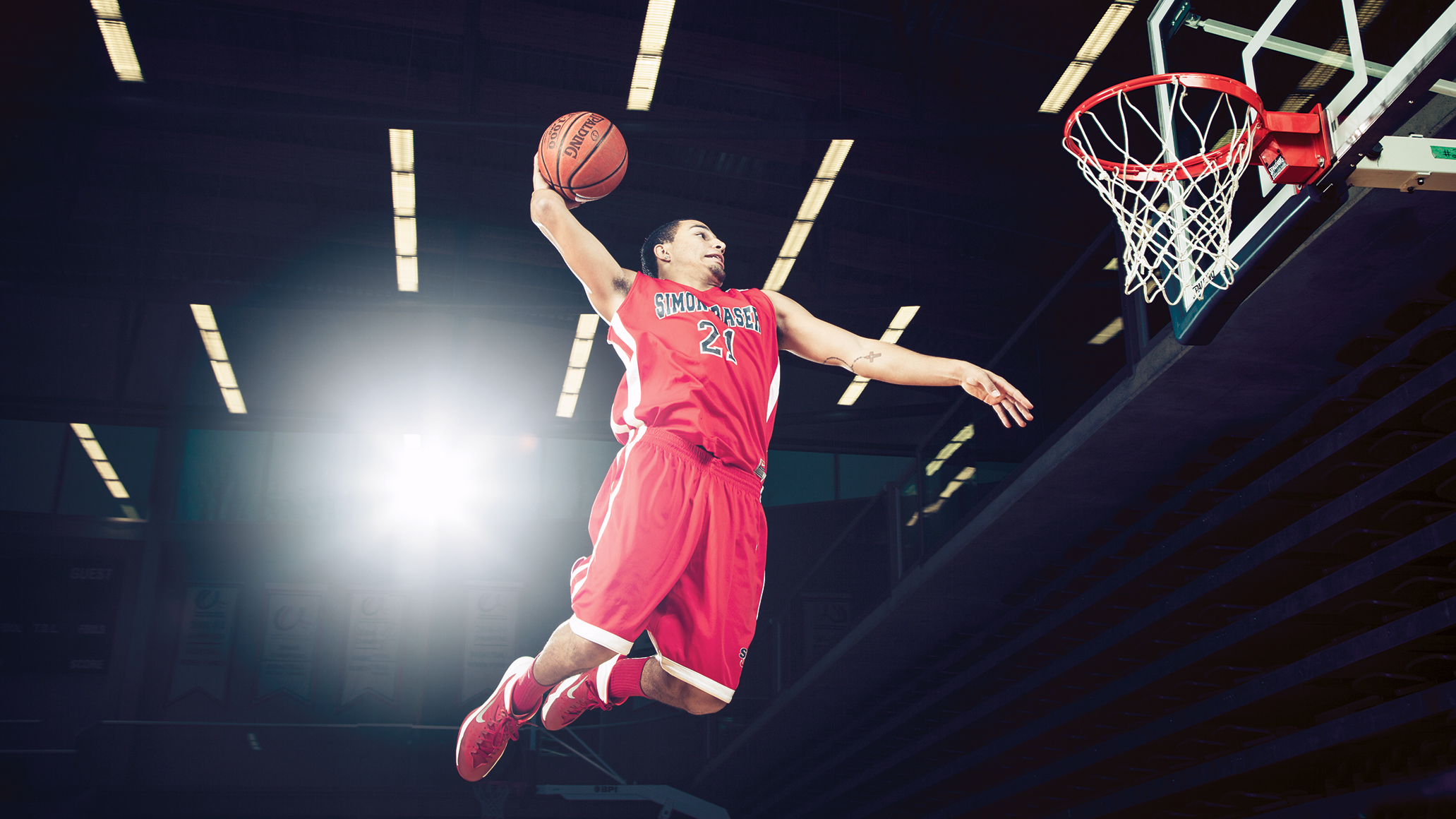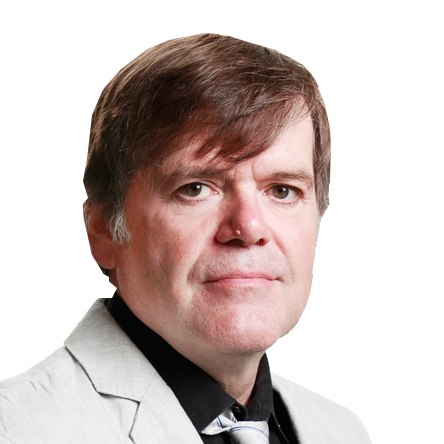Chris Bargholz chased down a long, searching ball on the left side of the pitch. Deep in second overtime, he had run miles and his legs were filled with sand. In his peripheral vision, Bargholz picked up his teammate Carlo Basso running toward goal and into space. Bargholz crossed the ball and drained his battery doing it. He didn’t see what happened with the cross as he fell to the grass. It ended up landing at Basso’s feet and then in the back of the net. Simon Fraser University, the fourth seed, had staved off elimination in the championship tournament. Basso, a senior from Coquitlam, B.C., had not yet played his last game for the Clan. Bargholz, a business major from Germany, struggled to get to his feet to celebrate. If Basso hadn’t struck the ball cleanly, Bargholz was taking a 10 count—no way he was getting back up to defend his position.
Inconsistent for much of the fall of 2013, SFU had knocked off the No. 1–ranked home team, and Basso was the hero. It was improbable stuff, but even more unlikely was the setting: Jesse Owens Stadium on the campus of Cal State Los Angeles. Or the crowd: “We’re the only collegiate team that goes on the road and hears ‘U.S.A., U.S.A.’ chants from fans,” Basso says. With a 2–1 victory over Cal State L.A., the Clan was advancing to the third round of, well, think of it as November Madness: the NCAA Div. II soccer championship tournament.
The athletic department at Simon Fraser has what might be the ultimate wild-card status in Canadian university sport: Its teams compete in the otherwise all-American NCAA. Other Canadian schools occasionally get to measure themselves against NCAA programs; for instance, hoop teams from Div. I schools, even national champions, come north to play CIS teams in exhibitions. But SFU is unique in that it’s the only school outside of the U.S. to be a member in full standing with the NCAA. Okay, it’s not like Ohio State or Alabama or Notre Dame have SFU on their schedule. This season, the men’s soccer team had matches against the South Dakota School of Mines & Technology Hardrockers and the Northwest Nazarene Crusaders. Still, those in the athletic department in Burnaby, B.C., view their program as a mission, and maybe a portent of what university sport in Canada might look like a generation from now.
SFU’s road to NCAA status has been tortuous and started out with a risible ambition. When the school was established in 1965, its founding chancellor was Gordon Shrum, a physicist who admired the U.S. model for collegiate sport from afar and vowed that within 10 years SFU would land a team in the Rose Bowl. NASA managed to land men on the moon and return them safely to Earth before the decade was out, but joining the elite ranks of U.S. collegiate sports proved to be a far more daunting task for SFU. Suffice it to say that they have yet to play in Pasadena on New Year’s Day.
Still, for most of its history, Simon Fraser recruited top athletes, offered them scholarships and played against other not-ready-for-the-Rose-Bowl players in the NAIA, a loop for smaller U.S. schools. At various junctures, certain programs in the athletic department also participated in the CIAU or CIS. In 2008, though, the NCAA cracked its door open and allowed Canadian schools to apply for standing in the loop, albeit in Div. II. SFU took the NCAA up on its offer. After lobbying for months and filing a metric ton of paperwork, SFU was granted provisional Div. II status in its pilot program in 2010.
To steer the athletic department through this transition, SFU needed to find an institutional rainmaker. Enter Milt Richards, a man of boundless energy and enthusiasm, hired in November 2011 as the school’s athletic director. Born in Syracuse, N.Y., Richards had been athletic director at Kansas State at age 32, the youngest in the NCAA. He had overseen the University of Albany’s transition from Div. II to Div. I. At Cal State Stanislaus, he managed to triple the annual athletic budget to over $2.2 million, upgraded facilities and drew in $6.5 million in private-sector support. Those were challenges, though not like the ones he faced at SFU.
Only when SFU joined the NCAA did the school’s board of governors understand how provisional its provisional status was and how protracted the process of gaining full status could be. Some would have thought that SFU had hit a brick wall. Others would have thought that a brick wall would be more flexible than the NCAA. “To be a member of the NCAA, you need to be accredited by one of the U.S. accrediting agencies,” Richards says. “That’s a bylaw. [The accreditation process] used to take three years but now it takes seven. They were saying that because we weren’t accredited, we were provisional members and not eligible for championships.”
As it turned out, when Richards arrived on campus that fall, there was an SFU varsity team richly deserving a shot at one of those championships: the men’s soccer program. The team finished the season ranked first in the NCAA Div. II coaches’ poll. “It was gut-wrenching as it got toward the end of the schedule,” says Basso, who was named the 2011 Great Northwest Athletic Conference’s player of the year. “That team worked so hard and had such great leadership that you had to feel for the seniors. They were going to finish their careers without something they deserved. I feel like one of the lucky ones, having a chance to play in the tournament the past couple of seasons [2012 and ’13]. I’m like other [underclassmen] from 2011. The experience of having to go to the sidelines and not play in the championships makes you hungry. You’re playing today for those guys who didn’t get their fair chance.”
The unfairness stung not only the players on the soccer team but all varsity student-athletes. “In 2010, that first year when varsity teams had provisional status, we were not competitive against NCAA Div. II opponents,” Simon Fraser football coach Dave Johnson says. “Our varsity teams got crushed. For the soccer team to play as well as it did the next year, that was bringing us legitimacy across the board. It was a point of school pride, a team of primarily Canadian athletes wearing a maple leaf on the sweaters, beating Americans in their own league. It’s us vs. them, but even though they let us in, they didn’t give us a fair shot, which the soccer team deserved.”
Richards embarked on a campaign to win the hearts and minds of the NCAA bureaucrats who hold the organization’s cinderblock-thick rule book as immutable as the Constitution. It would be like trying to beat a traffic ticket in front of a hanging judge in a speed-trap town. The NCAA’s rules-enforcement officers don’t give out free passes.
Using all his experience and working all of his connections, Richards went to presidents of other Div. II schools and to those who write NCAA legislation and made a case for SFU being given an exemption from the bylaws regarding accreditation. He and other SFU administrators explained that some of the school’s academic departments were already accredited in the U.S. and all were probably going to be approved in time. Richards and SFU beat very long odds against them. “The council was able to see it our way and recommended that, as long as a school in the Canadian pilot program was a candidate for [U.S.] accreditation and as long as a school is in good standing with the Canadian government, the NCAA would give us the waiver and allow varsity teams full status.”
When SFU set about hiring Richards, he had to wait 10 weeks before federal labour-market authorities determined that no Canadian could fill the job as the school’s athletic director. No doubt there wouldn’t have been a homegrown administrator who could have landed the varsity teams on the fast track.
In 2012, the men’s soccer team made the Div. II final four but lost in the semifinals. This year, again, they’ve made it there and are bidding to be the first school to have to go through customs on the way home after winning an NCAA title.
Sometimes Clan teams across the 17 varsity sports still feel like outsiders or second-class citizens when they’re on the road. They’re able to laugh off the little indignities—arriving at U.S. schools where officials can’t find a Canadian flag or a version of the anthem for pre-game ceremonies. Other stuff cuts deeper. “When fans are heckling the country you come from or the city you live in, not just giving your mascot a hard time, you take it personally,” Johnson says.
Even harder to take, though, was the NCAA officials’ decision last year when drawing up the men’s soccer tournament schedule: Though SFU earned a top seed and with that the right to host games in the opening rounds, the NCAA put the Clan on the road, at a lower seed’s home field no less, because there were concerns that some opponents might not have all the necessary paperwork for their players to travel to Canada.
Richards tries to put a positive spin on it. “We’re in full standing competitively, but we’re still in transition culturally, I guess,” he says. “It’s something new, and there’s going to be a learning curve for everybody on both sides. It’s early, but I feel like we’re blazing a trail here. If other Canadian schools follow us down this road, they’ll benefit from our experience and find the transition easier.”
The object lesson from Simon Fraser’s entry into the NCAA fray turns the cliché inside out: The Clan is finding out that to beat them, you have to join them.
This story originally appeared in Sportsnet magazine. Subscribe here.


